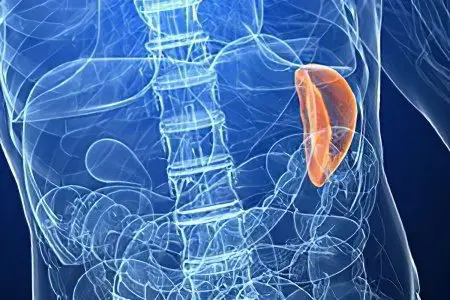Contents

Hemangioma of the spleen – This is one of the most common benign tumors of the spleen, and lymphoma, on the contrary, is the most common malignant tumor of the spleen.
Hemangioma is a tumor of the blood vessels, which is most often detected incidentally, as they are rarely accompanied by pronounced symptoms.
Lymphoma of the spleen A disease in which cells of the body’s immune system are affected. It proceeds without symptoms and is detected incidentally.
In fact, hemangioma is a benign proliferation of blood vessels and is most often located on the skin, but it also occurs on internal organs, including the spleen. Depending on the structure, hemangiomas are most often divided into three types: capillary, cavernous and mixed. Capillary hemangiomas consist of small vessels of the capillary type. Usually they are small in size, homogeneous, with clear, even contours.
Cavernous – from vascular cavities, they are most often much larger than capillary hemangiomas, they have clear bumpy contours and a heterogeneous structure, and mixed ones combine both types of hemangiomas.
Lymphomas, unlike hemangiomas, are not so easily divided into types, moreover, the stage of development of the lymphoma plays a more important role than its type. At the moment, modern doctors have managed to separate and describe more than 30 types of lymphomas, which greatly helps in the diagnosis and subsequent treatment, because the specific result of treatment and recovery of a person may depend on how accurately this will be determined.
Most often, lymphomas are divided into Hodgkin’s lymphomas and non-Hodgkin’s lymphomas, predominantly found in people aged 50-60 years. In order to find out what type of lymphoma is found in a patient, it is required to do a spleen biopsy, according to the results of which it is already possible to determine the type of lymphoma, its stage, and prescribe the necessary treatment.
In the diagnosis of hemangiomas of internal organs, ultrasound is most often used. Although hemangioma is one of the most common benign tumors of the spleen, in fact they are quite rare and, in principle, do not have characteristic symptoms, which is why they are most often diagnosed by chance. In the case of the development and growth of such a tumor, pain may appear in the left hypochondrium with recoil to the left shoulder.
Spleen hemangiomas are more easily tolerated by children, and if formed in an adult, they can significantly disrupt its work and even lead to a dangerous spleen infarction. At the moment when the lymphoma of the spleen passes from its sluggish state to the stage of manifestations, certain symptoms begin to appear, which are most often associated with the fact that the spleen increases in size and begins to put pressure on neighboring organs.
So, for example, there may be complaints about premature satiety when eating, complaints of pain in the left hypochondrium. Spleen lymphoma can also manifest itself through the following symptoms: severe sweating, weight loss, increased body temperature in the evening and at night, which cannot be brought down with antibiotics.
Methods of diagnosis
Today, biopsy, computed tomography, ultrasound, MRI, blood tests, bone marrow, etc. are used to diagnose spleen lymphoma. In this case, a spleen biopsy is the main test for the necessary diagnosis of this malignant tumor.
Treatment
In most cases, the treatment of hemangiomas is based on exceptional diagnosis, the study of tumors using ultrasound, x-ray methods and angiography. In benign tumors of the spleen, such as hemangioma, the necessary splenectomy is used, which leads to a cure, but in the case of lymphomas and other malignant tumors of the spleen, splenectomy can be used only in the early stages of the disease.
Unlike hemangiomas, the treatment of spleen lymphomas is much more complicated and the main role in it is played by the diagnosis of the disease, that is, it is necessary to find out what kind of lymphoma has formed in the spleen, and at what stage it is. Based on the results obtained, the doctor prescribes the necessary treatment, which, thanks to the development of medicine, leads to a complete cure in 90% of cases.
If a patient has been diagnosed with spleen lymphoma in a sluggish stage, without pronounced symptoms, then most likely the doctor will not take any emergency measures, and will carefully monitor the course of the disease, at the necessary time intervals, conducting all the mandatory examinations and tests.
In case of exacerbation of symptoms, treatment will be started, which, depending on the severity of the disease, may include not only splenectomy, which will help stabilize the patient’s health for some time (up to 5 years), but also chemotherapy, radiation.









